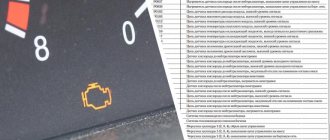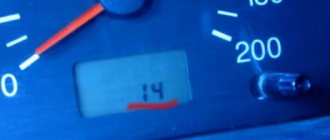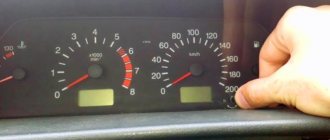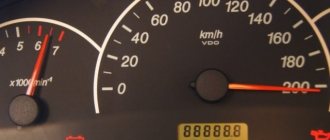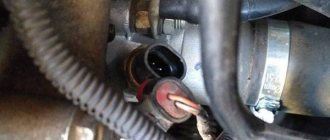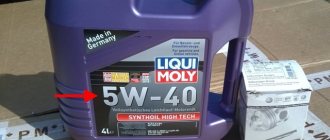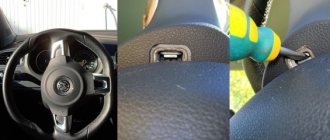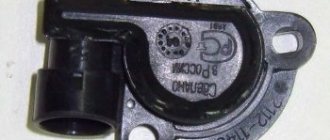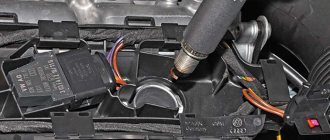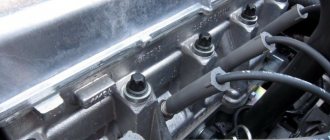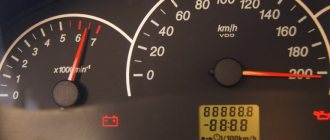When a malfunction occurs, the engine control unit in the Volkswagen Polo V sedan informs the driver about this using the Check Engine warning lamp and reduces engine response, regardless of the cause of the problem. You can find out by reading the error codes from the Volkswagen Polo V ECU. This article will tell you how to do this, how to decipher the received codes and erase them from memory.
Necessary equipment
For self-diagnosis you will need:
- diagnostic scanner-cord VAG COM 409.1 or HEX-USB+CAN;
- one of the utilities: VCDS: works only with HEX-USB+CAN;
- “Vasya diagnostician” v1.1: works with VAG COM 409.1 KKL USB, VAG-COM 409.1 COM port or HEX-USB+CAN;
- VAG K+CAN Commander v1.4 or v2.5: works with VAG COM 409.1 KKL USB, VAG-COM 409.1 COM port, VAG K+CAN.
When to pay attention to the engine
There are codes that affect the engine and its performance. For example, previously an engine repair was required, due to which it was necessary to disassemble the gas distribution mechanism drive.
If the drive is assembled incorrectly, error 0016 is issued. When the camshaft adjuster valve is destroyed, the system issues error 0010. It is corrected by replacing the valve.
Cleaning the EGR system valve is required if error P0403 is present. Often, high mileage of a Volkswagen Polo car leads to the appearance of code P2002 - in this situation, you need to go to a car service center, where instructions on further actions will be given. Most often, such an error occurs when the particulate filter of one of the cylinder blocks wears out.
Deciphering error codes
The explanation of the most common errors in the 1.6-liter Volkswagen Polo V engine is given in the table below.
| VAG code | Code ODB-2 | Malfunction |
| 16489 | P0105 | Damage to the electrical circuit of the air flow meter sensor |
| 16496 | P0112 | Low signal level of air temperature sensor |
| 16497 | P0113 | High level of air temperature sensor signal |
| 16500 | P0116 | Damage to the electrical circuit of the coolant temperature sensor |
| 16501 | P0117 | Coolant temperature sensor signal low |
| 16502 | P0118 | High signal level of the coolant temperature sensor |
| 16505 | P0121 | Damage to the electrical circuit of the throttle position sensor |
| 16506 | P0122 | Low throttle position sensor signal |
| 16507 | P0123 | Throttle position sensor signal high |
| 16514 | P0130 | Damage to the electrical circuit of the oxygen sensor |
| 16515 | P0131 | Low oxygen sensor signal |
| 16516 | P0132 | High signal level of the oxygen sensor |
| 16517 | P0133 | Slow response of oxygen sensor |
| 16518 | P0134 | Poor oxygen sensor performance |
| 16519 | P0135 | Damage to the electrical circuit of the heated oxygen sensor |
| 16520 | P0136 | Damage to the electrical circuit of the downstream oxygen sensor |
| 16521 | P0137 | Low signal level of the lower oxygen sensor |
| 16522 | P0138 | High signal level of the lower oxygen sensor |
| 16525 | P0141 | Damage to the electrical circuit of the heated oxygen sensor |
| 16585 | P0201 | Damage to the electrical circuit of the fuel injector of cylinder 1 |
| 16586 | P0202 | Damage to the electrical circuit of the fuel injector of cylinder 2 |
| 16587 | P0203 | Damage to the electrical circuit of the fuel injector of cylinder 3 |
| 16588 | P0204 | Damage to the electrical circuit of the fuel injector of cylinder 4 |
| 16614 | P0230 | Damage to the electrical circuit of the fuel system |
| 16684 | P0300 | Random misfires |
| 16685 | P0301 | Misfire in cylinder 1 |
| 16686 | P0302 | Misfire in cylinder 2 |
| 16687 | P0303 | Misfire in cylinder 3 |
| 16688 | P0304 | Misfire in cylinder 4 |
| 16710 | P0326 | Damage to the electrical circuit of the knock sensor |
| 16719 | P0335 | Damage to the electrical circuit of the crankshaft angle sensor |
| 16720 | P0336 | Random malfunctions of the crankshaft angle sensor |
| 16726 | P0342 | Low signal level of the camshaft position sensor |
| 16727 | P0343 | Camshaft position sensor signal high |
| 16806 | P0422 | Poor catalytic converter efficiency |
| 16828 | P0444 | Open circuit in the activated carbon canister cleaning valve |
| 16829 | P0445 | Activated carbon canister cleaning valve circuit shorted |
| 16885 | P0501 | Damage to the electrical circuit of the vehicle speed sensor |
| 16890 | P0506 | Reduced idle speed |
| 16891 | P0507 | Increased idle speed |
| 16946 | P0562 | Low voltage in the vehicle's on-board network |
| 16947 | P0563 | Increased voltage in the vehicle's on-board network |
| 16990 | P0606 | Internal damage to the ECM |
| 17531 | P1123 | Rich fuel mixture |
| 17532 | P1124 | Lean mixture |
| 17535 | P1127 | Long-term over-enrichment of the fuel mixture |
| 17536 | P1128 | Long-term leanness of the fuel mixture |
| 17918 | P1510 | The idle air system valve is constantly open due to a short circuit in the valve coil power supply circuit. |
| 17921 | P1513 | The idle air system valve is constantly open due to a break in the electrical supply circuit to the valve coil |
| 17960 | P1552 | The idle air system valve is constantly closed due to a short circuit in the valve coil power supply circuit. |
| 17961 | P1553 | The idle air system valve is constantly closed due to a break in the electrical supply circuit to the valve coil |
| 18013 | P1605 | Damage to the electrical circuit of the acceleration sensor |
| 18014 | P1606 | Inappropriate signal received from acceleration sensor |
| 18018 | P1610 | MIL Input Low |
| 18019 | P1611 | MIL Input High |
How to decrypt correctly?
Below are the most common warnings that appear on the instrument panel during a vehicle self-test.
| Display text | Meaning |
| SERVICE | Maintenance service reminder occurs 3000 km before the due date |
| SERVICE JETZT | Carry out maintenance immediately |
| AIRBAG FEHLER | Problems with the airbag system |
| BEIM EINLEGEN EINER FAHRSTUFE IM STAND FUSSBREMSE BETATIGEN | Press the brake pedal before shifting the automatic transmission selector |
| BREMSBELAG PRUFEN | Critical wear of brake pads |
| STOP! BREMSENFEHLER BETRIEBSANLEITUNG! | Error in the brake and ABS drive system. This may occur when the electronics fail or the liquid level in the circuit drops below the permissible level |
| HANDBREMSE ANGEZOGEN! | Handbrake lever not released |
| GENERATOR WERKSTATT! | Damage to generator windings |
| LICHTMASCHINE WORKSHOP | Wear of the generator brush assembly |
| MOTORSTORG WERKSTATT! | Malfunctions in the engine control system. Can be duplicated with a burning EPC icon |
| STOP! KUHLMITTEL PRUFEN BETRIEBSANLEITUNG! | Overheating or drop in liquid level in the cooling system |
| STOP! OLDRUCK MOTOR AUS! | Reduced level (yellow indicator) or drop in pressure (red indicator) of oil in the engine lubrication system |
| OLSENSOR WERKSTATT! | The pressure sensor is broken, with a yellow indicator on the combination |
| WASCHWASSER FULLEN | Windshield wiper fluid level low |
| BITTE TANKEN | Turning on the reserve fuel remaining in the tank |
| CHECK | Various problems in the emission control system |
There are special tables to decipher error codes. Listed below are some of the most common problems in Volkswagen cars.
Reset and clear errors
It is not possible to remove errors by removing the terminal from the negative pole of the battery, since the volatile memory of the ECM runs on the battery installed in it. Therefore, there are only two ways to reset errors on a Volkswagen Polo V sedan: contact a service station or do it yourself using a diagnostic cord. The procedure for using the “Vasya Diagnostic” utility as an example is as follows:
- Launch the utility.
- Connect the cord to the diagnostic socket.
- Change the initial speed value in the program settings from 0 to 9600.
- Click “Troubleshooting”, in the “Select vehicle” column leave “Auto detection” (if there is a CAN bus) or manually select the model (if there is no CAN bus).
- Click "Run".
Wait for the process to complete and click “Remove faults”.
Reasons that can cause the Check Engine to light up
If the check light comes on after visiting a gas station, then the likely cause is low-grade fuel. The fuel may not meet the recommended octane rating or may contain low-quality additives.
When refueling with low-grade gasoline, the power unit begins to operate unstably. The electronic control unit detects the presence of detonation and tries to adjust the ignition timing. The following symptoms are observed:
- the revolutions begin to float;
- engine power drops;
- fuel consumption increases;
- during acceleration, significant detonation appears;
- The car stalls when cold or hot.
The appearance of the Check Engine light may be due to problems in the oil circuit. If the replacement interval is violated or low-grade oil is used, the pressure in the system may decrease.
In this case, the surfaces of the mating parts do not receive sufficient lubrication. Therefore, there is a risk of scoring and damage that can completely immobilize the power unit. The Check Engine light may also appear as a result of the oil level dropping below the permissible level.
Many car owners note that the check engine light on the Volkswagen Polo sedan occurs after overcoming deep puddles. There are many reasons for this:
- Water gets on the surface of the oxygen sensor, which results in its sudden cooling and improper operation.
- If the electrical wiring is damaged, moisture can enter and cause current leakage. As a result of this, the power unit begins to operate unstably. The electronic control unit reacts by igniting the check.
- The layout of the lower part of the engine compartment is such that there are a lot of elements that are exposed to moisture when driving through puddles. Some sensors are located in unprotected places, so getting water on them leads to failures in receiving information from the ECU.
Overheating of the power plant is also the cause of the check. Car owners most often encounter this problem when stuck in a traffic jam for a long time. The lack of oncoming air flow reduces engine cooling, and a standard radiator with a fan is not enough in hot weather.
This is interesting: How to bleed the brakes on a Volkswagen Passat b5
EPC signal on the dashboard of a Volkswagen car
Often, failures in the operation of individual vehicle systems occur unnoticed by the driver. However, these failures can cause more serious damage in the future. The main signs that you should pay attention to, even if the warning lights do not light up on the dashboard:
If any of these signs appear, you should immediately take the car to a service center for diagnostics. Ignoring such situations will result in a red window lighting up on the instrument panel indicating an engine malfunction, which is always accompanied by a five or six-digit code.
This is an EPC error, and the code indicates which system has failed.
Video: EPC error appears on Volkswagen Golf
Problems with other car components
Some errors occur only under certain circumstances, for example, if the car has a DSG robotic gearbox, then if there are problems with the mechatronics, error P189C occurs. Also a signal for an immediate replacement of the mechatronics is error P17BF. If you tamper with the control unit, which contains information about the vehicle’s mileage, error 00476 is displayed.
In order for this error to stop appearing on the display, the system must be recoded. The presence of a modern audio system in a car does not mean that it is completely protected from interruptions - the output of error 00463 just means that you need to check the control unit of this system, as well as its wiring.
How climate control works
New generation climate systems are based on the use of an air conditioner, which bears the main burden of responsibility for ensuring comfort in the cabin. The use of automation made it possible to maintain the specified microclimate parameters without human intervention. A complex climate control air conditioning system works on the principle of mixing warm air coming from the power unit with cold air generated by the air conditioner in the required proportion. For this, as well as for regulating the volume and direction of air supply, numerous dampers are used. The implementation of this principle of creating an optimal climate in the car interior allows you to obtain the following advantages in relation to a conventional ventilation/cooling system and car air conditioning:
Directions for use
| Attention: This summary can only be used if the options, control units and event recorder entries specified in it are applicable to the vehicle. |
Event Logger Entries
| Diagnostic address | Event Recorder Recording | Error type | Error Status |
| 01 – Engine electronics | P157000: Engine control unit blocked | sporadically (from time to time) | |
| 02 – Transmission electronics | P170100: Transmission control unit locked | sporadically (from time to time) | |
| 09 – On-board network control unit | U110100: Component protection enabled | statically (permanently) | |
| 5F – Information electronics 1 | U110100: Component protection enabled | statically (permanently) | |
| 15 – Airbags | U110100: Component protection enabled | statically (permanently) |
Climate control unit
As already noted, climate control, being an evolutionary development of a car air conditioner, is distinguished by the presence of special air ducts equipped with a large number of dampers for mixing flows of cold and warm air. Such dampers are controlled by a special controller that reads sensor readings and compares them with the specified ones.
If they do not match, the automation will send corrective signals to the climate control actuators of the Passat B6 in order to establish maximum correspondence between the specified and actual microclimate parameters. In this case, the actuators are damper servomotors, as well as the electric motor of the supply fan. The Passat B4 climate control design includes the following dampers:
The use of automation theoretically reduces the reliability of the climate system. But in practice, even the occurrence of malfunctions does not affect the performance of the climate control, which goes into emergency mode and continues to perform its immediate duties.
